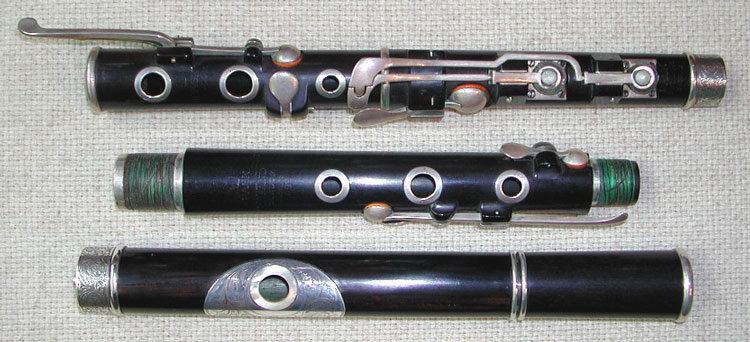|
Our task in this set of pages is to gather together what evidence remains about the
English maker John Pask, and to add what we can to that evidence.
If you happen to have a flute by Pask, we'll be pleased to hear from you
about it.
About John Pask
The New Langwill Index tells us that Pask flourished as a
maker of brass and woodwind instruments in London between 1840 and
1871. He was listed first as a "Flutemaker" (1841-42), expanding
that listing from 1852 to "Flute Maker and other Instruments".
Strangely, considering flute maker is the main entry, more brass instruments than flutes bearing his name seem to
have survived.
His Mark
Pask, like so many London makers, employed a unicorn
head as his mark. The NLI gives these forms of the mark:
His Address
Fortunately for us, Pask moved or changed his mark often,
making it easier to date his instruments. The NLI gives us:
-
1841: John Pask, 48 Strand
-
1842-47: John Pask, 8 Lowther Arcade
-
1848: John Pask, 7 & 8 Lowther Arcade
-
1851: Pask & Koenig, 441 Strand and 8 Lowther
Arcade
-
1852-54: John Pask, 441 Strand and 8 Lowther Arcade
-
1855-59: John Pask & Co, 443 Strand and 8 Lowther
Arcade
-
1860-70: John Pask & Co, 7 Lowther Arcade
-
1869-71: John Pask & Co, 36 Strand
In the Collections
There are a few Pask flutes in the leading institutional
and private collections. Let's see what we can learn from them.
Dayton C Miller collection (Library of Congress,
Washington)
Described by Miller as "Extra large fingerholes,
Nicholson style. Most beautiful specimen of ordinary system in
Collection." Miller believed it to be the late property of a Royal
person. The main mark is (unicorn head) / PASK / 8 LOWTHER
ARCADE / STRAND / LONDON. / PATENT / 622 / IMPROVED. It seems to fit
into the 1842-47 period.
The flute is a 9-key - the extra key being a duplicate Bb trill played
by R1. You can see its touch below the start of the ring at the top
of the right hand section in the image below. The other unusual
feature (apart from the ornate metalwork) is that C, C# and long F are all
fitted with rollers.

Pask #622. Cocus, ivory
cork-setting mechanism, mother-of-pearl bushing at embouchure, silver cap,
lip plate, keys, ferrules, inlaid silver rings at fingerholes, 658
mm. DCM 0353. Image DCM.
You can view this flute in extreme close-up detail by
going to the DCM
search site, entering DCM 0353 in the search box, pressing search,
selecting the first item, and then click on the image. Instructions
there will permit a very close look at any detail. Alternatively,
you can download the entire image and the software needed to view it.
Helen Valenza Collection
Helen instrument has many of the features of the DCM
flute, including the silver-lined key-slots. It's marked: (unicorn
head) / PASK / 8 LOWTHER ARCADE / STRAND / LONDON. / PATENT / 499.
It seems to fit into the same 1842-47 period.
We do have some dimensions - overall length 656mm,
speaking length 580mm, C# to Eb 255mm, size of hole five 10.6mm.
The C# to Eb length suggests it's in that period of flutes that play
best in the range 430 to 440, even though it will go much higher.

Pask #499. Helen Valenza
collection. Image T.McGee
Now we do have one more flute from the regular collections to show you,
but it introduces a whole new topic, so we'll make it the subject of a
separate page ....
|